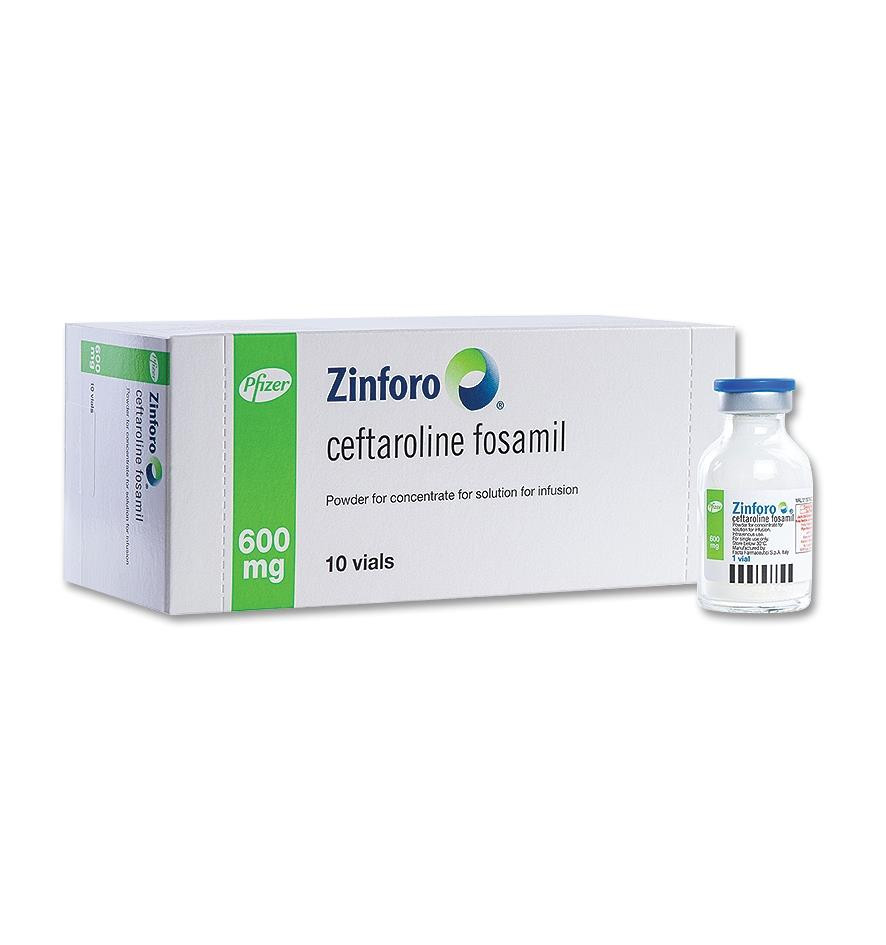600 mg vial:
৳ 4,600.00
Indications
Zinforo is indicated for the treatment of the following infections caused by susceptible isolates of the designated microorganisms:
- Complicated skin and soft tissue infections (cSSTI)
- Community-acquired pneumonia (CAP)
* রেজিস্টার্ড চিকিৎসকের পরামর্শ মোতাবেক ঔষধ সেবন করুন
Pharmacology
Ceftaroline is a cephalosporin with activity against Gram-positive and Gram-negative bacteria. In vitro studies have shown that ceftaroline is bactericidal, due to inhibition of bacterial cell wall synthesis by binding to penicillin binding proteins (PBPs). Ceftaroline is also active against methicillin-resistant Staphylococcus aureus (MRSA) and penicillin-nonsusceptible Streptococcus pneumoniae (PNSP) due to its affinity for the altered PBPs found in these organisms.
Dosage & Administration
The recommended durations of treatment are 5-14 days for Complicated skin and soft tissue infections (cSSTI) and 5-7 days for Community-acquired pneumonia (CAP).
Dosage in adults with normal renal function, creatinine clearance CrCl>50 ml/min:
a. For patients with supranormal renal clearance receiving the standard dose, an infusion time of 60 minutes
may be preferable.
b. Infusion times of less than 60 minutes and high dose recommendations are based on pharmacokinetic and
pharmacodynamic analyses only.
c. For treatment of S. aureus for which the ceftaroline MIC is ≤1 mg/L, the standard dose is recommended.
Dosage in adults with normal renal function, creatinine clearance CrCl>50 ml/min:
| Indications | Posology (mg/infusion) |
nfusion time (minutes)/Frequency |
| Standard dosea: Complicated skin and soft tissue infections (cSSTI) Community-acquired pneumonia (CAP) |
600 mg | 5-60b/every 12 hour |
| High doseb: cSSTI confirmed or suspected to be caused by S. aureus with an MIC = 2 mg/L or 4 mg/L to ceftarolinec |
120/every 8 hours |
may be preferable.
b. Infusion times of less than 60 minutes and high dose recommendations are based on pharmacokinetic and
pharmacodynamic analyses only.
c. For treatment of S. aureus for which the ceftaroline MIC is ≤1 mg/L, the standard dose is recommended.
* রেজিস্টার্ড চিকিৎসকের পরামর্শ মোতাবেক ঔষধ সেবন করুন
Interaction
No clinical drug-drug interaction studies have been conducted with ceftaroline.
The interaction potential of ceftaroline on drugs metabolised by P450 enzymes is expected to be low, since ceftaroline is not an inhibitor (CYP1A1, CYP1A2, CYP2A6, CYP2B6, CYP2C8, CYP2C9, CYP2C19, CYP2D6, CYP2E1 and CYP3A4) nor an inducer (CYP1A2, CYP2B6, CYP2C8, CYP2C9, CYP2C19, or CYP3A4/5) of P450 enzymes in vitro. Zinforo is not metabolised by P450 enzymes in vitro, so co-administered P450 inducers or inhibitors are unlikely to influence the pharmacokinetics of ceftaroline.
In vitro, ceftaroline is not transported by efflux transporters P-gp or BCRP. Zinforo does not inhibit P-gp, therefore an interaction with substrates, such as digoxin, is not expected. Zinforo is a weak inhibitor of BCRP, but the effect is too small to be clinically relevant. In vitro studies demonstrated that ceftaroline is not a substrate of, nor did it inhibit the renal uptake transporters OCT2, OAT1, and OAT3; drug-drug interactions with drugs that inhibit active renal secretion (e.g., probenecid) or with drugs that are substrates of these transporters would therefore not be expected.
The interaction potential of ceftaroline on drugs metabolised by P450 enzymes is expected to be low, since ceftaroline is not an inhibitor (CYP1A1, CYP1A2, CYP2A6, CYP2B6, CYP2C8, CYP2C9, CYP2C19, CYP2D6, CYP2E1 and CYP3A4) nor an inducer (CYP1A2, CYP2B6, CYP2C8, CYP2C9, CYP2C19, or CYP3A4/5) of P450 enzymes in vitro. Zinforo is not metabolised by P450 enzymes in vitro, so co-administered P450 inducers or inhibitors are unlikely to influence the pharmacokinetics of ceftaroline.
In vitro, ceftaroline is not transported by efflux transporters P-gp or BCRP. Zinforo does not inhibit P-gp, therefore an interaction with substrates, such as digoxin, is not expected. Zinforo is a weak inhibitor of BCRP, but the effect is too small to be clinically relevant. In vitro studies demonstrated that ceftaroline is not a substrate of, nor did it inhibit the renal uptake transporters OCT2, OAT1, and OAT3; drug-drug interactions with drugs that inhibit active renal secretion (e.g., probenecid) or with drugs that are substrates of these transporters would therefore not be expected.
Contraindications
- Hypersensitivity to the active substance or to any of its excipients.
- Hypersensitivity to the cephalosporin class of antibacterials.
- Immediate and severe hypersensitivity (e.g., anaphylactic reaction) to any other type of beta-lactam antibacterial agent (e.g., penicillins or carbapenems).
Pregnancy & Lactation
Pregnancy: No clinical data on pregnancies are available for ceftaroline. Animal studies with ceftaroline fosamil do not indicate harmful effects with respect to fertility, pregnancy, parturition or postnatal development. Zinforo should not be used during pregnancy unless clearly necessary and only if the potential benefit outweighs the possible risk.
Lactation: It is not known whether ceftaroline is excreted in human milk, but because many beta-lactams are excreted in breast milk, women who are breast-feeding should be treated with Zinforo only if clearly indicated. Interruption of breast-feeding is recommended.
Lactation: It is not known whether ceftaroline is excreted in human milk, but because many beta-lactams are excreted in breast milk, women who are breast-feeding should be treated with Zinforo only if clearly indicated. Interruption of breast-feeding is recommended.
Precautions & Warnings
Hypersensitivity reactions: As with all beta-lactam antibacterials, serious and occasionally fatal hypersensitivity reactions are possible. Severe cutaneous adverse reactions (SCARs), such as Stevens-Johnson syndrome (SJS), toxic epidermal necrolysis (TEN), drug reaction with eosinophilia and systemic symptoms (DRESS), and acute generalised exanthematous pustulosis (AGEP) have been reported in patients taking beta-lactam antibiotics. Patients who have a history of hypersensitivity to cephalosporins, penicillins or other beta- lactam antibacterials may also be hypersensitive to Zinforo. Before initiating therapy with Zinforo, careful inquiry should be made concerning previous hypersensitivity reactions to beta-lactam antibacterials. If a patient developed an immediate and severe hypersensitivity (e.g., anaphylactic reaction) previously to any type of beta-lactam antibacterial, Zinforo should not be administered. If a severe allergic reaction or SCAR occurs, the medicinal product should be discontinued and appropriate measures taken.
Storage Conditions
Keep below 30°C temperature, away from light & moisture. Keep out of the reach of children.

